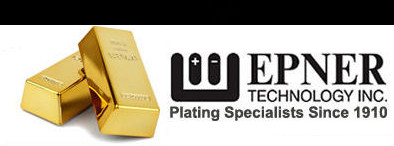Why Specify Laser Gold®:
Many of the products that require both the highest IR reflectance, and ruggedness to permit physical cleaning, specify Laser Gold on the drawing. As one aerospace engineer remarked, “It’s my name in the ‘Designed By’ box in the corner of the drawing. Sourcing the critical coating process is one way to insure the integrity of my work.” In short, Laser Gold is a space-proven, field-tested process for more than twenty years. Hubble, NJST (James Webb Telescope), Keck, and Mars Surveyor are just a few of the high-reflectivity projects that rely on Laser Gold to enhance their flawless performance. Countless other programs have called out Laser Gold it for it’s high IR reflectivity, low emissivity, and superior thermal control properties. Does your project deserve any less?
How To Specify Polished Laser Gold®:
Simplified Basic Specification:
“Gold coat per Epner Technology, Brooklyn, New York Laser Gold specification #2011”.
With this call out your parts will be plated with a .25 micron of Laser Gold. This assumes the component will be received at Epner ready for Laser Gold plating that is in nickel or copper or stainless steel. No polishing at Epner is anticipated. See below for Diffuse Laser Gold information. Process EP2777.
More Detailed Specification:
Electrochemically deposited gold. Total reflectivity shall be equal to or greater than 97% at 0.7 microns when measured on a Perkin-Elmer Lambda 750 Spectrophotometer with integrating sphere or equivalent. A suitably prepared witness sample plated concurrently with the product may substitute for direct measurement when applicable. Hardness shall be minimum 180 Knoop when measured by the diamond indenter method of ASTM-B-578-87.
Aluminum and Beryllium Substrates:
Caution: The nickel thickness specified herein is only meant for optical surfaces that will be diamond turned or optically lapped, subsequent to nickel plating:
Typically, aluminum and beryllium substrates are coated with .004”-.008” optical grade electroless nickel-phosphorus prior to imparting the final optical figure and subsequent Laser Gold plating. Epner Technology is presently researching techniques that will eliminate the heavy nickel, i.e. gold direct on the diamond turned or polished surface
Laser Gold can be specced thicker if you need to part to have a Laser Damage Threshold. If this is the case, I would recommend .00008-.0001” (2-2.5 micron) of nickel.
Also, if you require Laser Gold to do more than reflect; be conductive, corrosion resistant or be used for RF, you can specify a thicker Gold- 1.25-2.5 microns thick.
Aluminum Alloys / Ti / 6AL4V
- GOLD COAT PER EPNER TECHNOLOGY, BROOKLYN, NEW YORK LASER GOLD SPECIFICATION #2011,
GOLD PLATING THICKNESS .00001 TO .00002 INCH (0.25 TO 0.5 MICRONS) - UNDERPLATE WITH ELECTROLESS NICKEL PLATE PER ASTM B733, TYPE V, SC2, CLASS 1,
OR PER SAE AMS2404, CLASS 1, WEIGHT PERCENT PHOSPHORUS GREATER THAN 9%
NICKEL PLATING THICKNESS .0005 TO .001 INCH (13 TO 25 MICRONS)
TESTING FOR COATING ADHESION, COMPOSITION, AND THICKNESS REQUIRED
Aluminum and Beryllium Substrates not meant for optical polishing:
Most low emissivity applications should be specified, but generally require a minimum of .0005″ to a maximum of a mil high phosphorous electroless nickel
Stainless Steel, Invar 36, Copper
- GOLD COAT PER EPNER TECHNOLOGY, BROOKLYN, NEW YORK LASER GOLD SPECIFICATION #2011,
GOLD PLATING THICKNESS .00001 TO .00002 INCH (0.25 TO 0.5 MICRONS) - UNDERPLATE WITH ELECTROLESS NICKEL PLATE PER ASTM B733, TYPE V, CLASS 1,
OR PER SAE AMS2404, CLASS 1, WEIGHT PERCENT PHOSPHORUS GREATER THAN 9%
NICKEL PLATING THICKNESS .0001 TO .001 INCH (2.5 TO 25 MICRONS)
TESTING FOR COATING ADHESION, COMPOSITION, AND THICKNESS REQUIRED
How To Specify DIFFUSE Laser Gold® Process EP2777 :
Process EP277: Diffuse Laser Gold.
- GOLD COAT PER EPNER TECHNOLOGY, BROOKLYN, NEW YORK LASER GOLD SPECIFICATION #2011,
Gold Thickness is .000050” – .000075” unless otherwise stated on PO.
- UNDERPLATE WITH ELECTROLESS NICKEL PLATE PER ASTM B733, TYPE V, SC2, CLASS 1,
OR PER SAE AMS2404, CLASS 1, WEIGHT PERCENT PHOSPHORUS GREATER THAN 9%
NICKEL PLATING THICKNESS .0005 TO .001 INCH (13 TO 25 MICRONS)
TESTING FOR COATING ADHESION, COMPOSITION, AND THICKNESS REQUIRED - Sandblast substrate and Ni Coating with 120 Grit, 120 PSI, 12-18″ away for even diffuse coverage.
Dielectric Substrates:
Zerodur, Pyrex, Quartz, BK7 and certain plastics, etc. all require a vapor-deposited binder coating prior to Laser Gold plating. Epner Technology uses well-established coating firms to achieve an adherent binder coating with no distortion to the optical figure.
